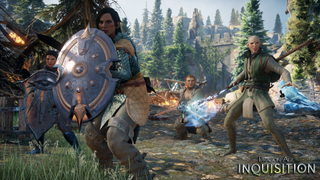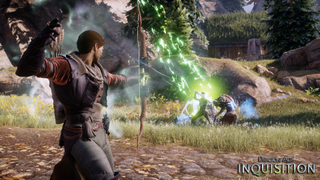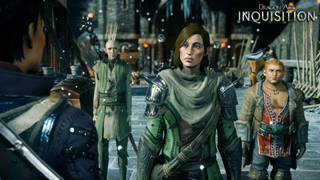
These somewhat unfortunate events all occur while out exploring the The Hinterlands. It’s in this open, sprawling, pleasantly bucolic (aside from all the monsters and rebel templars) region that Inquisition’s debt to Skyrim and Far Cry 3 becomes abundantly clear. In order to open up other regions and access new story missions, first you need to accrue Power. That’s done in a number of ways: completing quests (“A missing fiancee, eh? Don’t worry, I’m sure nothing untoward has happened...”), discovering and claiming campsites, which are also used for quick travel, and sealing the smaller breaches, which are protected by groups of enemies who vary in power and number. So essentially you have to grind the map. Which is fine, so long as the encounter types and core systems are fun to interact with, which they mostly seem to be.
The most important of these elements is, of course, the combat, which again enables players to mix realtime action with a more tactical approach. Spin back on the mouse wheel to zoom the camera out, or tap T, and you’ll pause time. From here you can assign targets to party members, order them to take potions, or choreograph their movement as carefully as your inner Sun Tzu demands. I only found the need to dip into it during the meatier encounters, like a battle with a three-storey tall Prideful Demon in which it proved advisable to keep the characters close to each other for quick revives, or have them focus on the spawning mobs before returning their attention to the boss.

For the most part, though, playing on normal difficulty I was able to let the AI look after itself. Deeper in, I suspect I’ll need to tweak some of the parameters which tell characters what abilities to favour and under what circumstances to use potions. Because I’d chosen to play as a mage, my party was a little too heavy on ranged damage and I found that switching Varric from using Bianca, his signature crossbow, to operating close with a decent dagger we’d found provided a much better balance. Again, glancing at a colleague’s screen, I noticed that they were whirling around the battlefield like a refugee from a Platinum game, which seemed quite a bit more dynamic than my stand-at-the-back-and-spam-spells-for-max-DPS approach. But the fact you can hotswap between all party members should provide welcome scope for variety.
There’s a balance to be struck between hand holding and tossing players alone into the Marianas Trench
With some relief I can also report that the mouse and keyboard interface, and the menus in general, feel like they’ve been designed considerately. I’m slightly less convinced, though, by how the game explains its multitude of systems early on. Clearly there’s a balance to be struck between overly explicatory hand holding and tossing players alone into the Marianas Trench, and in general I’d rather be allowed to work things out for myself, but a few elements felt unnecessarily opaque.

Both the acquisition of new health potions and how to quick travel left me baffled initially, but had simple explanations. Less clear was how I should have been spending my time in order to advance the story. (Certainly not by collecting endless amounts of Elfroot I was never going to have time to use. Goddamn you, terrifying compulsion to collect herbs.) For example, once you’ve acquired sufficient Power, you need to return (physically, not just through an interface) to the War Council in Haven, where you can open the World Map and dispatch scouts allied to different advisors, each of whom favours a particular approach—brute force, diplomacy, etc.
It wasn’t entirely clear whether these scout missions could fail somehow, or how much I should be focusing on trying to build Influence—another type of currency, which unlocks Inquisition perks that can grant access to new dialogue options, savings at merchants, improved drop rates and so on. I’m not convinced any of these are serious issues to worry about though. Almost every big RPG has an almost anti-honeymoon period during which you’re acclimatising to how its systems operate and how to most efficiently level and gear your characters. My suspicion is that it won’t take much longer than I played for most of this stuff to start feeling comfortable.
Speaking to executive producer Mark Darrah afterwards, he confirmed that the team consciously opted to avoid nannying the players too much. He also told me that one of the key motivations at the outset of development on Inquisition was to make the game feel big and open again, whereas Dragon Age II had felt narrower compared to Origins. (You can read that whole interview here.) He also makes it clear that the monumental success of Skyrim has opened the door for RPGs—especially sweeping, explorative ones—to dominate the mainstream. Couple that with the resurgence of classic computer RPGs in the form of Wasteland 2, Divinity, and Pillars of Eternity, and we’re potentially entering a golden era for the genre.
The biggest gaming news, reviews and hardware deals
Keep up to date with the most important stories and the best deals, as picked by the PC Gamer team.
It glimmers with polish and is packed with things to see and do.
In terms of where Dragon Age: Inquisition fits into that, we’ll know better on November 18. But aside from some quibbles with how it doles out information, based on my time with it, the game feels likely to be the epitome of the modern, big budget RPG. It glimmers with polish and is packed with things to see and do. The fact that The Witcher 3 and several other potentially big games have been delayed also gives it a pretty clear run at Christmas.

Towards the end of the session I wander into an area called Blood Cliffs, and am horrified and excited to find an enormous dragon and its also sizeable hatchlings roaming around. It takes to the air and begins harrying my soon dwindling party. Dumbly, rather than turn back I press forwards into the next clearing, despite the anguished cries of my teammates, who now surely realise what sort of leader they’re following. By the time we make it to the next area ‘we’ has become ‘I’, with only Solas left alive and under my control. There he finds not salvation, but another dragon that’s almost double the size of the previous one, which promptly puts him out of his misery. I wonder how many hours it will take to deal with that sort of encounter without being massacred. What I can say for certain is that five hours have rarely felt like they’ve passed so fast.
With over two decades covering videogames, Tim has been there from the beginning. In his case, that meant playing Elite in 'co-op' on a BBC Micro (one player uses the movement keys, the other shoots) until his parents finally caved and bought an Amstrad CPC 6128. These days, when not steering the good ship PC Gamer, Tim spends his time complaining that all Priest mains in Hearthstone are degenerates and raiding in Destiny 2. He's almost certainly doing one of these right now.
Most Popular






